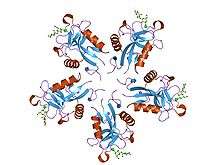C-type lectin
A C-type lectin (CLEC) is a type of carbohydrate-binding protein domain known as a lectin.[3] The C-type designation is from their requirement for calcium for binding.[4] Proteins that contain C-type lectin domains have a diverse range of functions including cell-cell adhesion, immune response to pathogens and apoptosis.[5][6]
| Lectin C-type domain | |||||||||
|---|---|---|---|---|---|---|---|---|---|
 | |||||||||
| Identifiers | |||||||||
| Symbol | Lectin_C | ||||||||
| Pfam | PF00059 | ||||||||
| InterPro | IPR001304 | ||||||||
| SMART | CLECT | ||||||||
| PROSITE | PS50041 | ||||||||
| SCOPe | 2msb / SUPFAM | ||||||||
| CDD | cd00037 | ||||||||
| Membranome | 52 | ||||||||
| |||||||||
Classification
Drickamer et al. classified C-type lectins into 7 subgroups (I to VII) based on the order of the various protein domains in each protein.[7] This classification was subsequently updated in 2002, leading to seven additional groups (VIII to XIV).[8] Most recently, three further subgroups were added (XV to XVII).[3]
| Group | Name | Associated domains |
|---|---|---|
| I | Lecticans | EGF, Sushi, Ig and Link domains |
| II | Asialoglycoprotein and DC receptors | None |
| III | Collectins | None |
| IV | Selectins | Sushi and EGF domains |
| V | NK - cell receptors | None |
| VI | Multi-CTLD endocytic receptors | FnII and Ricin domains |
| VII | Reg group | None |
| VIII | Chondrolectin, Layilin | None |
| IX | Tetranectin | None |
| X | Polycystin | WSC, REJ, PKD domains |
| XI | Attractin (ATRN) | PSI, EGF and CUB domains |
| XII | Eosinophil major basic protein (EMBP) | None |
| XIII | DGCR2 | None |
| XIV | Thrombomodulin, CD93, CD248, CLEC14A | EGF domains [9] |
| XV | Bimlec | None |
| XVI | SEEC | SCP and EGF domains |
| XVII | CBCP/Frem1/QBRICK | CSPG repeats and CalX-beta domains |
CLECs include:
- CLEC1A, CLEC1B
- CLEC2A, CLEC2B, CD69 (CLEC2C), CLEC2D, CLEC2L
- CLEC3A, CLEC3B
- CLEC4A, CLEC4C, CLEC4D, CLEC4E, CLEC4F, CLEC4G, ASGR1 (CLEC4H1), ASGR2 (CLEC4H2), FCER2 (CLEC4J), CD207 (CLEC4K), CD209 (CLEC4L), CLEC4M
- CLEC5A
- CLEC6A
- CLEC7A
- OLR1 (CLEC8A)
- CLEC9A
- CLEC10A
- CLEC11A
- CLEC12A, CLEC12B
- CD302 (CLEC13A), LY75 (CLEC13B), PLA2R1 (CLEC13C), MRC1 (CLEC13D), MRC2 (CLEC13E)
- CLEC14A
- CLEC16A
- CLEC17A
The "NK Cell lectin-like receptors" are a very closely related group:[10]
- KLRA1
- KLRB1 (CLEC5B)
- KLRC1, KLRC2, KLRC3, KLRC4
- KLRD1
- KLRF1 (CLEC5C)
- KLRG1 (CLEC15A), KLRG2 (CLEC15B)
- KLRK1
Additional proteins containing this domain include:
- AGC1; ATRNL1
- BCAN
- CD248; CD72; CD93; CHODL; CL-K1-Ia; CL-K1-Ib; CL-K1-Ic; CLECSF5; COLEC10; COLEC11; COLEC12; CSPG3
- FCER2; FREM1; HBXBP;
- LAYN; LOC348174; LOC728276
- MAFA; MBL2; MGC34761; MICL; MRC1L1
- OLR1
- PAP; PKD1; PKD1L2; PLA2R1; PRG2; PRG3
- REG1A; REG1B; REG3A; REG3G; REG4
- SELE; SELL; SELP; SFTPA1; SFTPA2; SFTPA2B; SFTPD; SRCL
- THBD
- VCAN
References
- Walker JR, Nagar B, Young NM, Hirama T, Rini JM (April 2004). "X-ray crystal structure of a galactose-specific C-type lectin possessing a novel decameric quaternary structure". Biochemistry. 43 (13): 3783–92. doi:10.1021/bi035871a. PMID 15049685.
- Mahla RS, Reddy MC, Prasad DV, Kumar H (September 2013). "Sweeten PAMPs: Role of Sugar Complexed PAMPs in Innate Immunity and Vaccine Biology". Frontiers in Immunology. 4: 248. doi:10.3389/fimmu.2013.00248. PMC 3759294. PMID 24032031.
- Zelensky AN, Gready JE (December 2005). "The C-type lectin-like domain superfamily". FEBS J. 272 (24): 6179–217. doi:10.1111/j.1742-4658.2005.05031.x. PMID 16336259.
- C-Type+Lectin at the US National Library of Medicine Medical Subject Headings (MeSH)
- Drickamer K (October 1999). "C-type lectin-like domains". Curr. Opin. Struct. Biol. 9 (5): 585–90. doi:10.1016/S0959-440X(99)00009-3. PMID 10508765.
- Cambi A, Figdor C (May 2009). "Necrosis: C-type lectins sense cell death". Curr. Biol. 19 (9): R375–8. doi:10.1016/j.cub.2009.03.032. PMID 19439262.
- Drickamer K (1993). "Evolution of Ca(2+)-dependent animal lectins". Prog. Nucleic Acid Res. Mol. Biol. Progress in Nucleic Acid Research and Molecular Biology. 45: 207–32. doi:10.1016/S0079-6603(08)60870-3. ISBN 978-0-12-540045-9. PMID 8341801.
- Drickamer K, Fadden AJ (2002). "Genomic analysis of C-type lectins". Biochem. Soc. Symp. 69 (69): 59–72. doi:10.1042/bss0690059. PMID 12655774.
- Khan, K. A.; McMurray, J. L.; Mohammed, F.; Bicknell, R. (2019). "C-type lectin domain group 14 proteins in vascular biology, cancer and inflammation". FEBS Journal. 286 (17): 3299–3332. doi:10.1111/febs.14985. PMC 6852297. PMID 31287944.
- NK+Cell+Lectin-Like+Receptors at the US National Library of Medicine Medical Subject Headings (MeSH)
External links
- Functional Glycomics Gateway, a collaboration between the Consortium for Functional Glycomics and Nature Publishing Group